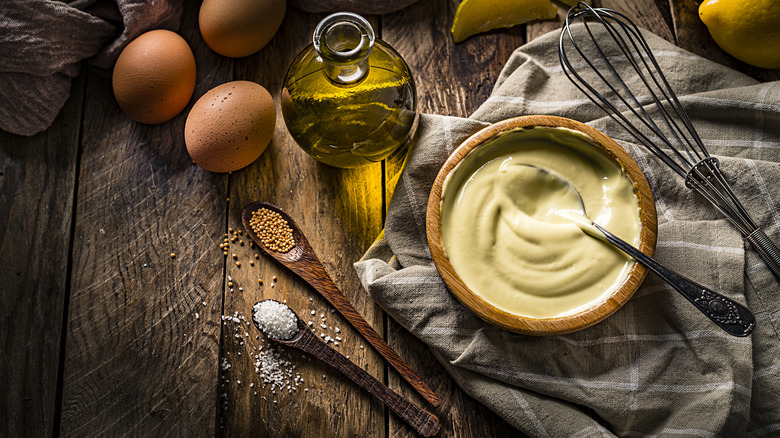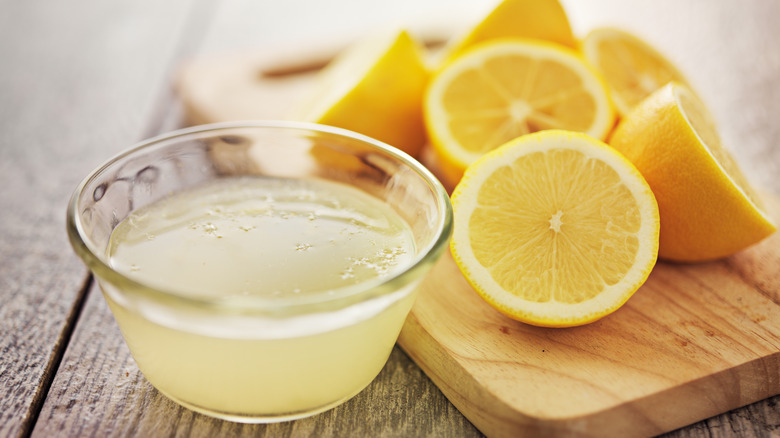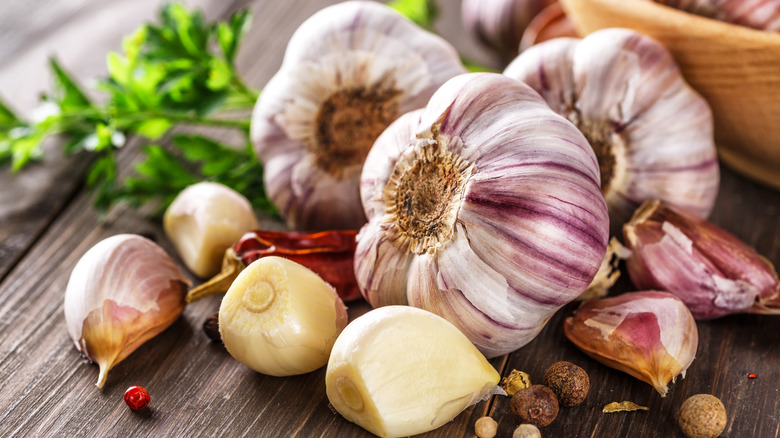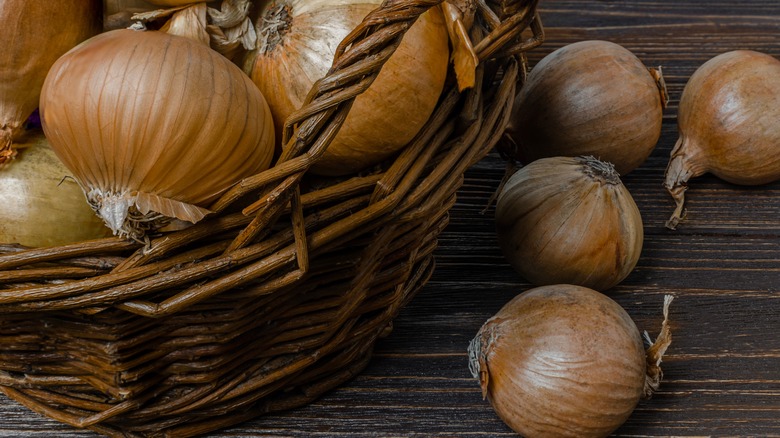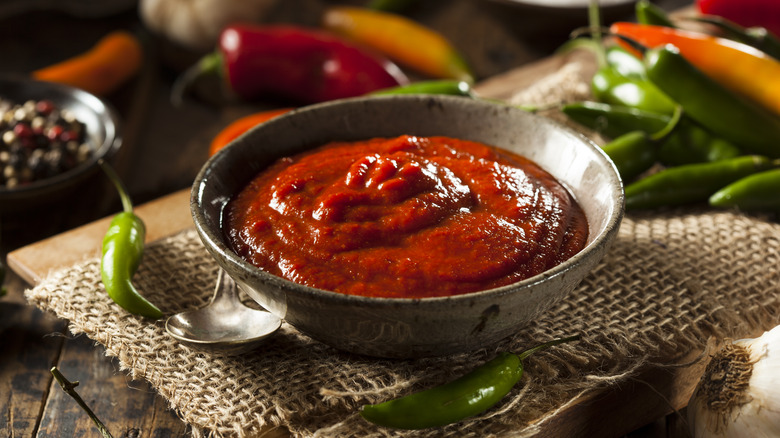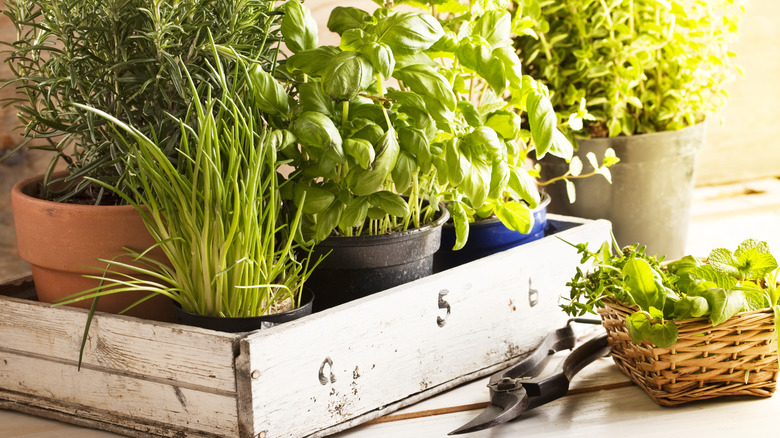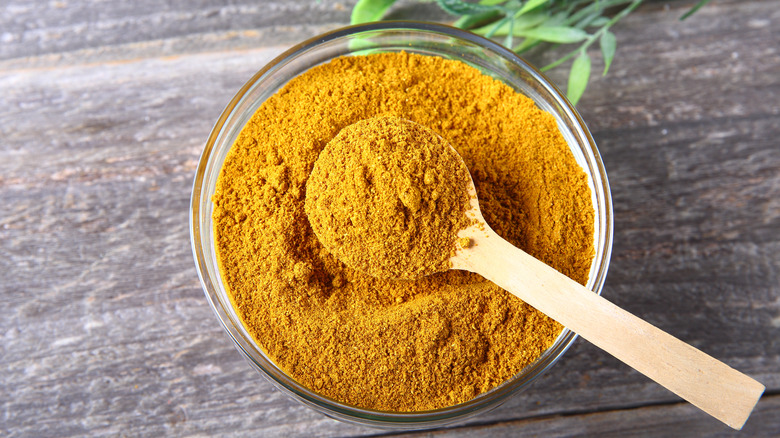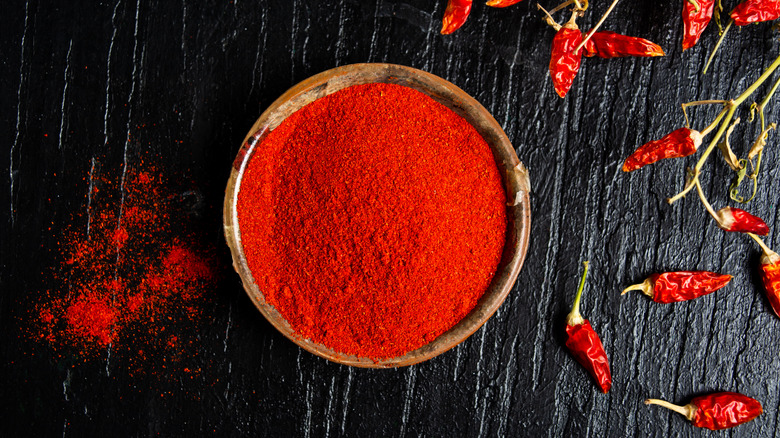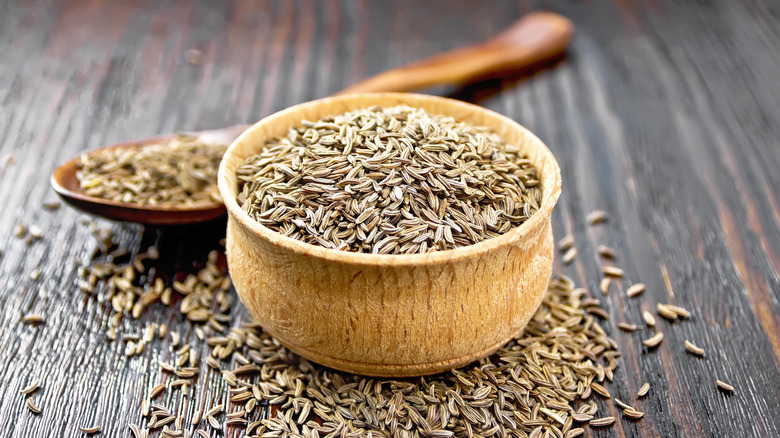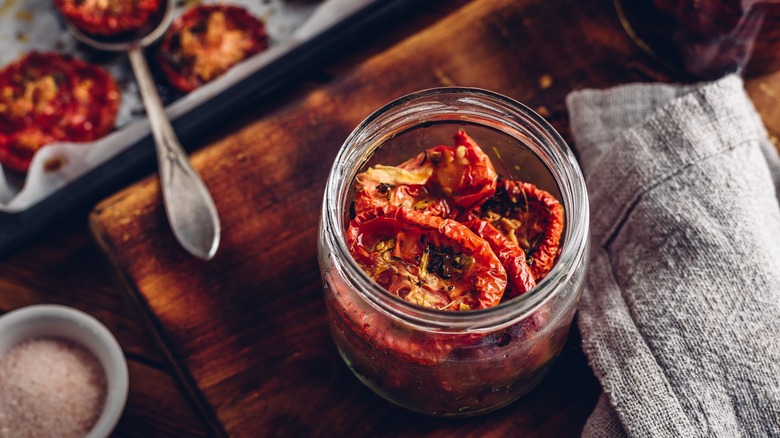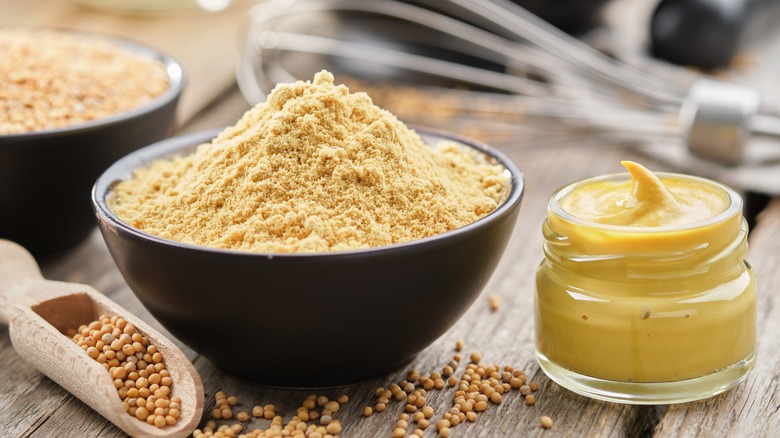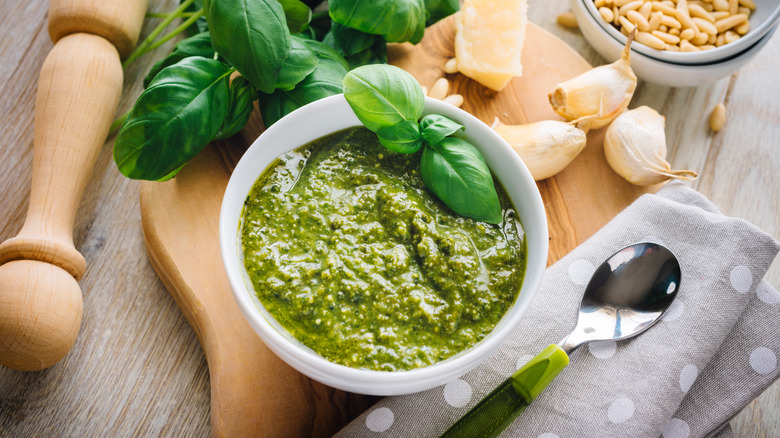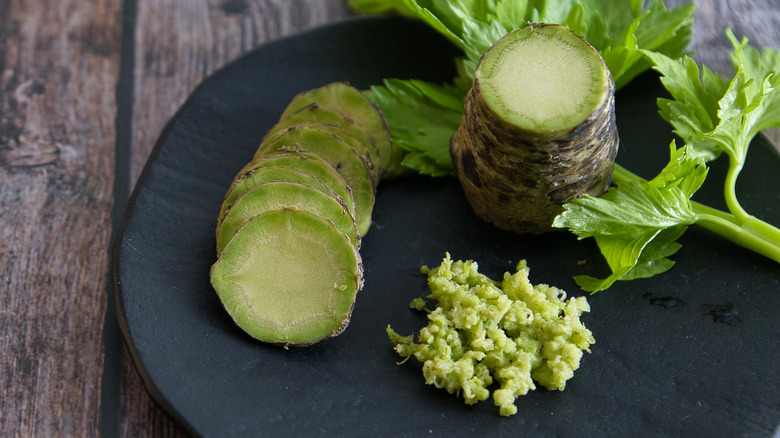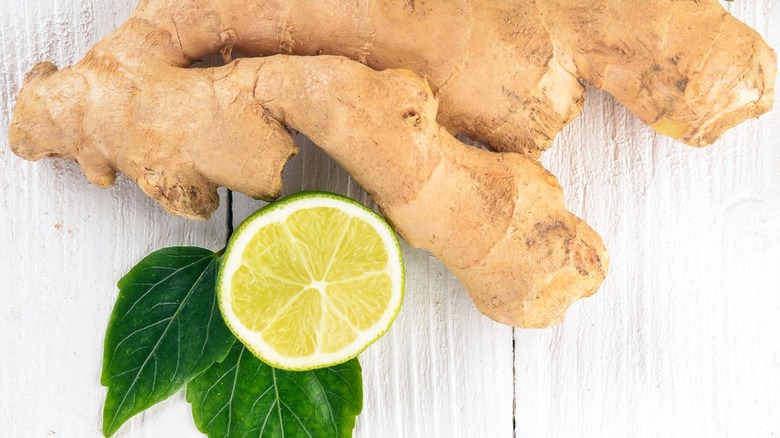Ingredients That Will Seriously Upgrade Your Homemade Mayonnaise
When it comes to making homemade mayonnaise, it helps to have a fool-proof recipe to follow. As long as you don't use the wrong kind of oil, you'll be sitting pretty with a jar of your own creation that lets you leave the store-bought stuff on the shelf. While the basics on the ingredient list may guarantee a creamy consistency and fresh flavor, you have plenty of choices if you're looking for something more dazzling than just a run-of-the-mill mayo. Having free rein of your add-ins gives you a world of options that turn up the taste and transform a simple schmear into a spectacular spread.
The relatively neutral base notes of mayonnaise make this deli delight a perfect canvas for decorating with all sorts of exciting extras. Don't make the mistake of thinking you have to be a consummate chef to achieve gourmet greatness with your mayonnaise mix-ins. We've collected a list of simple yet effective ingredients that will help you take your self-made mayo to the next level for sandwiches, salads, casseroles, and dips — any recipe where mayonnaise makes an appearance. Gear up for a selection of herbs, spices, and flavorings that are bound to give your homemade mayonnaise a culinary kickstart.
Lemon juice
Though it's a generally accepted ingredient in the basic recipe, an added squeeze of lemon juice in your homemade mayonnaise brings a sunny tanginess and lets you turn up the dial on the acid elements as high as you like. This tangy extra also helps elevate the other flavors you might find in the mix, as well as breaking down the eggs to transform the items in the bowl into the creamy creation you're going for. Imagine the silky smoothness of the finished product being punctuated by a little extra zing. It's enough to make mouths water just by reading that description.
Even if you have no grand plans for your homemade mayonnaise, having a lemony version in the fridge gives you a more gourmet flavor of the versatile condiment to use on simple sandwiches, and add to tuna or potato salad. You may even find it workable as a salad dressing by adding a bit more vinegar to thin it down, and a few shakes of salt and pepper to season it up. Let this unassuming kitchen hero come to the rescue wherever your usual mayonnaise would appear to surprise anyone who might be lucky enough to taste it.
Garlic
Garlic fans understand that there are few dishes a dash of this humble bulb can't improve, including homemade mayonnaise. Café Propaganda suggests dropping in two cloves' worth of garlic, finely minced, with a teaspoon of mustard and a bit of lemon juice to bring an aromatic earthiness to your mayo. To make sure the flavors have a chance to get to know one another, refrigerate your mix for at least an hour before serving. If you're feeling extra, you can roast your garlic to add a smoky, caramelized layer of sophisticated flavor. Then, use it to spruce up sandwiches of any kind, or drop it into recipes like egg salad where both flavor and mayonnaise are welcome guests.
But isn't garlic mayonnaise just aioli, that other glorious garlicky spread? Well, it is and it isn't. The facts about aioli are that it is an emulsion like mayonnaise, and it does use garlic as a flavoring ingredient. But while mayonnaise uses eggs to achieve its creamy texture, aioli is emulsified using only olive oil, resulting in a different and usually thicker consistency and bolder flavor. But hey — if you call your garlic mayonnaise "aioli," your secret will be safe with us.
Onion
You may be ready to add onions to your sandwich after spreading on your homemade mayo, but are you ready to add onions to the mayonnaise itself? The basic-but-not-bland taste of your mayo is just crying out for a little heat from onions. You wouldn't be the first to toss some into the jar; Jack in the Box has used onion mayo in the past as an upgrade to its offerings. If it's good enough for a fast food clown, it certainly has a place on your table.
With as many different types of onions as you'll find in the produce section or farmer's market, you can split your mayonnaise recipe and try a few different options to see which onion works best for you. One of the most tempting is roasted red onion, which brings out the sweetness without losing the perky punch altogether. Food.com suggests one medium red onion for every cup of mayonnaise you intend to flavor. Follow suit with other onion varietes and see which one makes your handcrafted spread sing with flavor. You might be surprised to find several winners in the bunch, each with their own unique elements to share.
Sriracha
Die-hards will already know that sriracha is a Thai sauce that brings the heat, courtesy of scorching red peppers with a vinegar bite. So, how about a little of this fire to challenge the cool creaminess of your finished mayonnaise? The fun of adding sriracha to your artisanal mayo is that you can add as much or as little as you want until you find the Goldilocks flavor that fits just right. And since sriracha comes as a prepared sauce, there's no extra kitchen work needed, other than twisting the familiar green top and squeezing the bottle into your other ingredients. A bit of a warning as you work: To prevent your mayo from over-emulsifying due to the extra vinegar, add the sriracha after you've finished your base recipe.
The combination of hot and creamy sauces goes with so many cultural dishes, and it may be tempting to try your sriracha mayonnaise on all of them. We say go for it! Slather it on egg rolls, use it in place of cream cheese, add it as a spicy mayo for sushi, or leave the sour cream behind and top tacos with it to set your fiesta en fuego.
Fresh herbs
Herbs are always welcome in a spread, no matter what your intended use. These elegant elements let you turn up the fresh flavor without overwhelming the simplicity of your mayonnaise recipe. Think about how much herbs like dill and chives do for buttermilk ranch or other creamy salad dressings, and you'll have an idea of how much a few well-chosen herbs will improve your creation. As Michigan State University points out, herbs are also a healthy add-in to your daily diet, and can reduce chronic inflammation and lower the risk of chronic diseases.
Just about any herbs you prefer will do here, though fresh herbs impart more flavor than dried ones. Add a tablespoon of dill and use your herb mayonnaise as a replacement for the store-bought mayo when making egg salad or veggie wraps. You can drop in chopped basil to bring a zesty Mediterranean essence that's perfect for dressing up falafel. And though it's a controversial little plant in its own right, if you're a cilantro fan, try a few snipped sprigs to bring the fresh flavor to dips for tortilla or corn chips made with your from-scratch mayonnaise. There's no harm in testing out herb blends to bring an even more complex profile to an herbal mayo recipe, either.
Curry
Bring a blast of international charm to your mayonnaise recipe by adding the warm umami tones of curry. A bold, aromatic spice found in Indian cuisine, curry is what gives familiar meat and chicken dishes their familiar warmth. When you wander beyond the usual boxes and bottles in the seasoning section of your local grocer, you find a variety of curry powders, each with its own personality. Yellow curry is your best bet for a mild flavor and is likely the taste profile you're most familiar with. Other variations like green and red curries ratchet up the spiciness with the addition of chili peppers. You can start with a single curry and see how it works, then add a bit of the other curries if you're looking for a more powerful flavor.
Curry mayonnaise makes an excellent dip for veggies and crackers, and it can even stand in for ketchup as a fry sauce that brings something special to the table. Top a baked potato with a dollop and some snipped chives over chickpeas, and you have an Indian-style dinner that's filling and flavorful. And, of course, this enticing blend is perfect for dipping homemade samosas.
Paprika
Paprika is a tricky spice, and one that few foodies realize is made from ground peppers. Paprika has a tendency to add warmth without bringing the heat, which makes it a great mayonnaise mix-in for lifting the sometimes-lazy jarred spread, even in its homemade form. The exciting red color of paprika will bring visual spectacle to the otherwise off-white tone of your spread as well. Knowing that we eat with our eyes first, anything that perks up the condiment selection with a new hue is bound to start a stir around the table.
Start by including a teaspoon or two of paprika, then taste it before adding more. Depending on your recipe, it may take some tinkering to get the balance right. Once you have it, use this terrific take as a sauce for seafood, or a toss for roasted potatoes to add creaminess and flavor. To take your spread in a woodsy direction, try using smoked paprika instead. You'll find a layer of hickory-like boldness that makes a satisfying complement to roast beef on sandwiches and smoked cheeses scattered about a charcuterie board. Sprinkle a bit of fresh paprika on top before serving to finish off your spread with a fancy flourish.
Cumin
From Mediterranean dishes to Indian classics and Mexican favorites, cumin is a spice that's treasured in a wide range of heritage cuisines around the world. This is the spice that gives taco seasoning its familiar zing, as well as finding its way into stews and rubs. You can find cumin in powdered or seed form at just about any grocery outlet or spice shop. In fact, the spice experts at McCormick point out that cumin is one of the top 10 best-selling spices in the U.S. That plus the comforting umami flavor should secure cumin a well-deserved place in your small-batch mayonnaise operation.
Cumin comes with a forceful flavor, so add a teaspoon to start and see how well it works for you. Add another teaspoon if necessary. For Mexican dishes that call for sour cream, consider substituting half for cumin mayo, and bring a new dimension to familiar fare that could use a glow-up. Try using it as a marinade for chicken to impart fresh flavor to breast cutlets, or legs and wings. This blend is also a comfortable passenger in pitas for gyros, and can even be spread on top of hummus to create a savory condiment cocktail.
Sun-dried tomatoes and oregano
Get sophisticated with your mayo spread by dropping in sun-dried tomatoes and oregano for a classic flavor combo. In addition to leading the flavor brigade, oregano is believed to have anti-inflammatory properties and may provide health benefits, such as treating indigestion and regulating blood sugar (per Medical News Today). Tomatoes have their own nutritional resume, which makes this dynamic duo a thoughtful couple of ingredients to bring into the homemade mayonnaise fold.
In their sun-dried form, you can find tomatoes dried or jarred in oil to toss into your recipe, and it will go well with fresh oregano. The mélange of flavors mimics fresh pizza sauce, a bold Italian taste that makes it a prime partner for roasted veggies on bagel sandwiches, and helps it put a mind-blowing spin on your run-of-the-cookout pasta salads. It's an out-of-control spread for steaks and shrimp in a surf-and-turf spectacular. You can even use it to glam up subs by giving your rolls a swipe of the savory spread before you pile on the toppings. If you happen to be serving pizza rolls at a party and there's a dish of sun-dried tomato and oregano sitting nearby, inviting guests to take a tasty dip, nobody will be mad.
Mustard
Mustard and mayonnaise share shelf space while keeping to their respective zones. But what if a little mix-and-match mayhem could combine this dynamic duo into a single concoction? You'd get a spread sensation that gives you the power of two beloved tastes in a single jar. This is more than just an advisable culinary move; it's also a savvy shift in refrigerator management ... just imagine the space you'll save!
Mustard has been in use for potentially thousands of years. What that means for you is a multitude of options when adding mustard to your mayo. Though you can try powdered mustard or grind your own seeds, you can also take the easy route to achieve delectable results. Grab a bottle of stone ground or Dijon, and add a dollop to bring top-tier class to your recipe. Or stick with the less-expensive yellow bottle and see how much tingle it musters. When you have a formula you like, try adding it to potato salad and egg salad, and find out how happy a mash-up it is. You can also use it with fish dishes in place of tartar sauce or as a mix-in for toasted tuna sandwiches.
Pesto
Nothing dresses up a modest recipe like mayonnaise better than the zingy, show-off flavors of pesto, especially if you create your own pesto for the occasion. True, preparing pesto by hand doubles the kitchen work for home cooks going for the full fresh-made experience. But even if you grab a tub of pesto from your local deli case and drop a generous dollop into your finished mayo, you're going to find happiness in food form at the end of your spoon.
As pesto has its roots in Italian cuisine, no one will be surprised to find this blend to be a sumptuous accent to Italian sandwiches and pasta dishes. Maximizing your pesto mayonnaise is just a matter of imagining where the flavors find a happy home, then making the switch. Think of it as a greener, more herbaceous take on an Alfredo sauce. For dinner parties or special evenings where the smaller fare is on the menu, consider picking up a sourdough bread boule from a nearby bakery, and serving your pesto mayo in place of spinach dip. Similarly, carrot sticks and snap peas couldn't find a more pleasing spread to replace ranch dressing in your collection of crudité.
Wasabi
How about some furious fire to bring out the blazing boldness in your freshly mixed mayonnaise? Wasabi, which is also known as Japanese horseradish, is the one to go with if you like the alternating sensation of heat and cool as you dine. Though you may not be using real wasabi (for reasons beyond your control), the wasabi you do use will be pretty robust, so be cautious. Start with a dab stirred throughout, and add more only if the flavor doesn't come through to your satisfaction. Then, light the fuse on this little firecracker in addition to your recipe and watch the sparks fly.
Wasabi mayo is a natural dipping sauce for sushi or sashimi, of course, combining the creaminess found in those familiar creations with the chopped wasabi you're likely to find on the sushi house table. Test out the taste with fried wontons, shrimp, or any other Asian dish where you might add wasabi in its raw form and see if this mayo modification is an equal pairing. You can also surprise guests at a family get-together by replacing regular mayo in your deviled eggs with a touch of wasabi mayo for a real conversation starter.
Ginger and lime
Try a fun Caribbean twist with ginger and lime to get your special spread island-bound. Ginger is one of the best-loved seasonings in Caribbean recipes, and lime is a natural match that lends flavor harmonics. These two are meant to make merry magic in your mayo mixing bowl. While some versions of bottled mayonnaise marketed in Mexico utilize lime juice as a flavoring, you can simply squeeze half a fresh lime to start with and see where it takes you. Remember to reduce the other acid in your recipe to prevent over-emulsifying. Grate some fresh ginger, and spoon it in until you find the calypso soul of your spread.
Serve up this audacious sauce with your favorite seafood and chicken dishes to give the recipes a breath of fresh air. Grill pork chops, tenderloins, and even corn on the cob, and add a generous slathering for added flavor. You can even transform a simple green salad into something to celebrate by thinning your mayonnaise with more lime juice and a bit of oil, and turning it into a creamy ginger-lime dressing. The possibilities for using this sun-soaked spread are only limited by your crafty culinary imagination.
